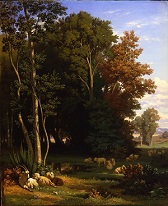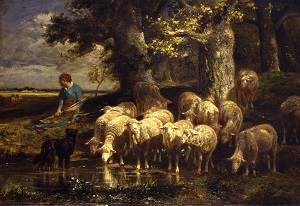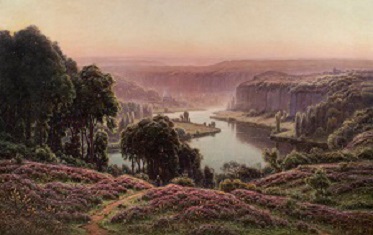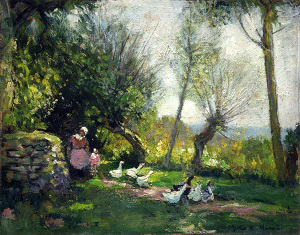The 19th century saw a remarkable rise in the popularity of landscape painting, which prompted many French artists to experiment with the genre and transform traditional ways of representing nature. Scenes of pastoral life have been prominent in Western art since at least the 17th century, when artists such as Claude Lorrain and Nicolas Poussin popularized the subject. These painters followed classicizing models to show an idealized form of nature, which remained the dominant mode of depicting nature into the early 19th century. The subject, however, ranked low in the hierarchy of the Royal Academy in France, and it was only in 1817, that a Prix de Rome prize was established for “historic landscape”—awarded every four years, but abolished later during the 1863 reforms. Jean-Achille Benouville (1815–91) won the prize in 1845, and as we see in Landscape with Animals (1842), he has followed the classical formula in his deft treatment of light and the careful delineation of foliage.
After the historical landscape tradition, Naturalism emerged as a major trend in the 1830s. Influenced by the work of earlier Dutch and Flemish landscape painters, as well as the English painter, John Constable (1770–1837), this trend focused on the faithful depiction of the French countryside rather than an idealization. Such paintings found a large audience as urban growth and industrialization generated nostalgia for rural life. The chief proponents of Naturalism were a group of artists who painted directly from nature or en plein-air in the Fontainebleau forest near the village of Barbizon. Among them, Constant Troyon (1810–65) became extremely popular with combining his Barbizon landscape observation and a passion for animals, such as in Flock of Sheep Approaching, or The Return of the Flock. Charles Emile Jacque (1813–94) also earned widespread popularity with the genre, and American Gilded age collectors particularly favored his paintings of sheep like A Shepherdess with her Flock (1852).
A new milestone for landscape painting was set, when the writers and art critics Jules and Edmond de Gongourt proclaimed at the Paris Universal Exposition of 1855 that “landscape is the victory of modern art.” As avant-garde artists emerged, such as the Realist painter Gustave Courbet (1819–77), and the Impressionist painters including Claude Monet (1840–1926) and Auguste Renoir (1841–1919), academic artists continued to renovate landscape painting. William Didier-Pouget (1864–1959), who was often grouped with the Impressionist movement—although he was not a formal member of the exhibiting group, painted atmospheric and lushly colored landscapes. Flowering Heather (Bruyères en fleurs) typifies his most popular landscape vision, dominated by fields of heather illuminated in soft light at the end or beginning of the day, on a scale traditionally reserved for history painting. Jules Hervé (1887–1981), born at the tail-end of the Impressionist movement, painted a series of “small paintings of the charming countryside.” Works like Geese presents a fusion of the Classical idealism and the humble subject matter of Realism, but one filtered through the loose brushwork and sparkling tones distinctive to Impressionism.







